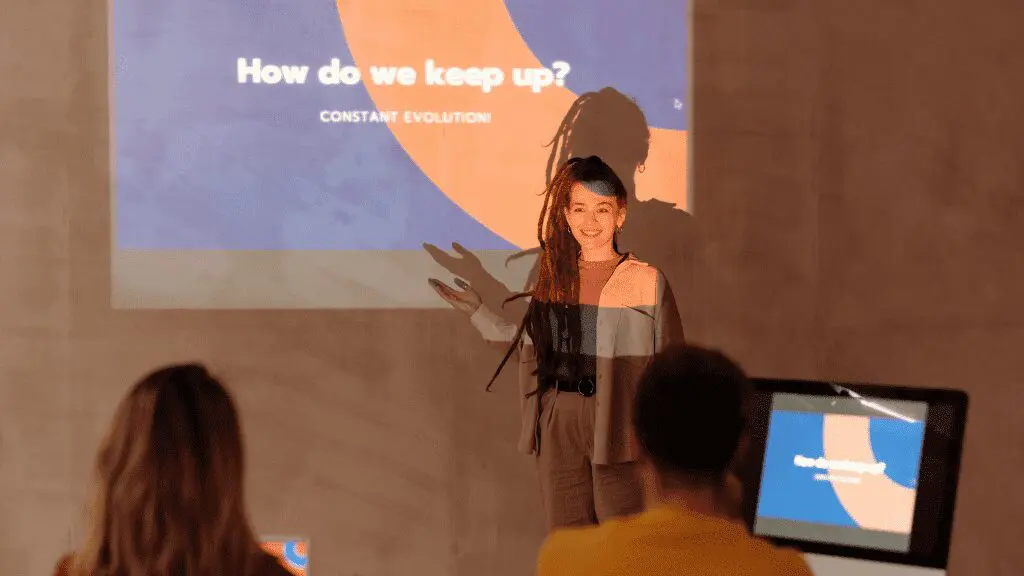If you’re a B2B sales professional, chances are you’ve had to give a presentation at some point in your career. The ability to deliver a compelling and persuasive message within a mere 10 minutes can make all the difference in securing those valuable deals. With attention spans dwindling and competition intensifying, mastering the art of the 10 minute presentation has become a crucial skill for sales teams.
This blog delves into the realm of 10-minute presentations and provides valuable insights, tips, and techniques to empower your B2B sales team. We’ll explore how to captivate your audience, deliver your message effectively, and leave a lasting impression, all within the constraints of a concise timeframe. Let’s unlock the potential of 10 minute presentations and elevate your sales game to new heights.
Know Your Audience
As you prepare your creative presentation, it’s important to know who will be viewing it. The more you can learn about their needs and preferences, the better equipped you’ll be to deliver content that resonates with them.
For example: Let’s say that one of your target audiences is a group of financial advisors who want to enhance their client communication strategies. If this is true, then it makes sense for you to include examples of how companies have used video explainer videos in similar situations.
Start with a Strong Hook
The first few minutes of your presentation are critical. You only have about 10 minutes to convince your audience that you know what you’re talking about, so you need to grab their attention and keep it from the very beginning.
The first moments of a 10-minute presentation are the most critical. It’s during this brief window of opportunity that you must captivate your audience and set the tone for what’s to come.
- Pose a Provocative Question: Begin with a thought-provoking question that relates to the core message of your presentation. For example, if you’re pitching a software solution for increased productivity, you might start with, Can you imagine doubling your team’s productivity in just a few clicks?
- Share a Startling Statistic: Startling statistics can instantly grab attention. For a great presentation on cybersecurity services, you could lead with, Did you know that a cyberattack occurs every 39 seconds? Are you prepared?
- Tell a Compelling Story: Weaving a brief story into your introduction can humanize your message and engage the audience emotionally. For instance, in a presentation about healthcare technology, you might share a patient’s success story.
- State a Bold Statement: Make a bold and memorable statement that challenges conventional thinking. Today, I’m going to show you how our innovation is reshaping entire industries.
- Use a Visual Surprise: Visuals can be incredibly powerful. Consider opening with a visually stunning image, SVGs or a simple but impactful video clip that relates to your message.
- Engage the Audience: Encourage audience participation from the get-go. Begin with a quick poll or ask a rhetorical question that requires a show of hands. This engages the audience immediately.
Content Selection and Prioritization

When it comes to content selection, you’ll want to offer guidance on choosing the most relevant and impactful content for a short presentation. The key is prioritizing key messages and information so your audience can get the most out of each minute they spend with you.
Visual Aids and Slides
Visual aids are an important part of any presentation, but they can also be time-consuming to create. If you’re pressed for time, consider using slides from another source like a template. You can also present a slide deck that’s already been created by someone else (i.e., your marketing team). You can use CustomShow to create enticing Visuals and Slides for your sales team.
When creating visuals for your presentation, remember:
- Visuals should enhance the message delivered in a 10-minute sales pitch; they should not be distracting or take away from it.
- Use bold colors and clear fonts on slides so they’re easy to read from afar without straining one’s eyesight too much while looking at them up close during the delivery of your speech/presentation/pitch etc!
- Use videos, infographics and high-quality images to avoid too much text.
- Show your company logo on the first and last slides to reinforce your brand identity. If you don’t have a strong logo yet, check out this guide on how to make an effective logo
Storytelling Techniques

Storytelling is an essential part of every B2B sales presentation. When done correctly, it can help you connect with your audience and make your message memorable. There are several storytelling techniques that you can use to make sure your story sticks with them:
- Customer Success Stories: Share real-life examples of how your product or service solved a customer’s problem, using specific data to demonstrate benefits and build credibility.
- The Hero’s Journey: Structure your story like a hero’s journey, showcasing your product as the hero that overcomes challenges and brings transformation to your customer’s world.
- Analogies and Metaphors: Use analogies or metaphors to simplify complex concepts and make them relatable, helping the audience better understand your message.
- The Problem-Solution-Result Formula: Present the problem, introduce your solution as the hero, and reveal the positive outcome, simplifying your narrative while keeping it impactful.
Delivering with Impact
When you’re presenting to your team, there are several things you can do to ensure that your message is delivered with impact.
- Confidence and Eye Contact: Project confidence in your delivery and maintain strong eye contact with your audience to establish trust and engagement.
- Vocal Modulation: Vary your tone and pacing to keep the audience engaged and emphasize key points effectively.
- Audience-Centric Approach: Tailor your presentation to address the audience’s needs and pain points, making them the focus of your narrative.
- Clear Call to Action: Conclude with a compelling call to action, guiding the audience on their next steps, whether it’s scheduling a follow-up or making a purchase.
Handling Q&A Sessions

The Q&A session is often the most stressful part of the presentation. You’ve got a limited amount of time, and you don’t want to leave any questions unanswered. On top of that, if you’re not prepared with questions that can be answered quickly and easily, then you may get stuck in an awkward silence while everyone waits for you to think of something else to say.
Here are some tips for handling Q&A sessions:
- Plan ahead by preparing questions for each point in your presentation, this will help keep things flowing smoothly when it comes time for questions from the audience.
- If possible, set aside a full minute at the end of each slide deck section (or subsection) so that attendees have ample time to ask questions or make comments before moving on to another topic or section entirely
Measuring Success
One of the best ways to measure the success of your 10-minute B2B sales presentations is by tracking key performance indicators (KPIs). These metrics help you understand how well your team is performing and where they need improvement.
The most common KPI for this type of presentation would be lead generation: how many leads did we generate from this event? Another important KPI to track is conversion rate, how many of those leads converted into customers?
It’s also important to know if there are any other factors affecting your ability to get results, such as whether or not everyone on your team was able to attend all events where they were scheduled in order for them all to work together effectively on future projects like this one!
Next Steps
We hope the presentation tips and techniques we’ve shared with you in this article will help you use your time wisely and effectively. Take a look at how CustomShow could help in your sales situations.

